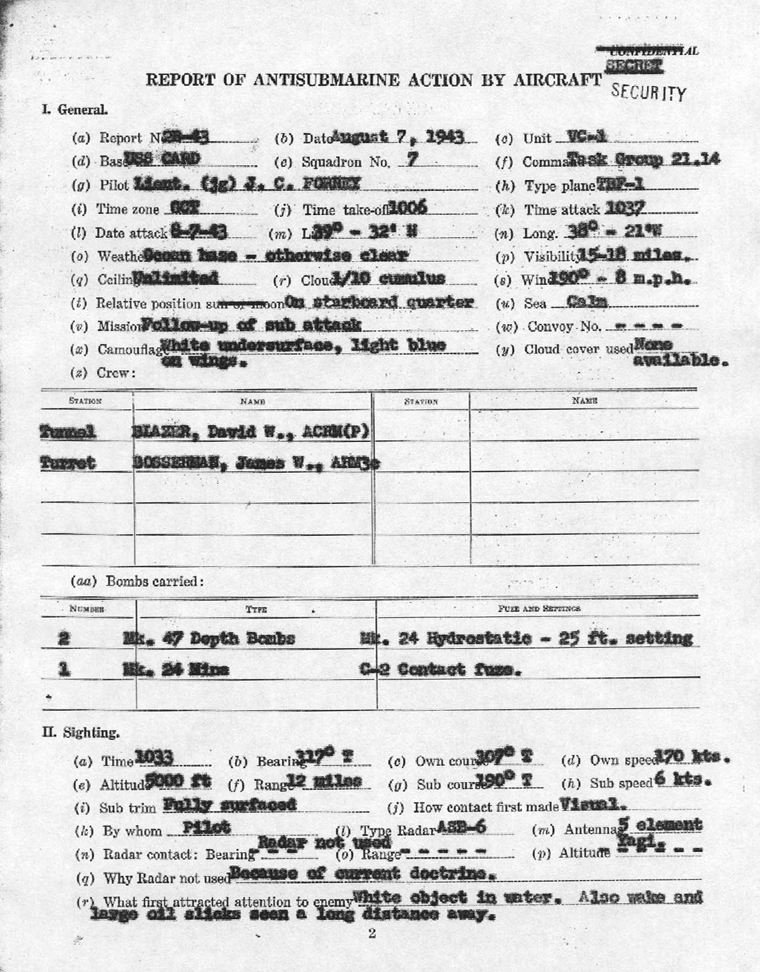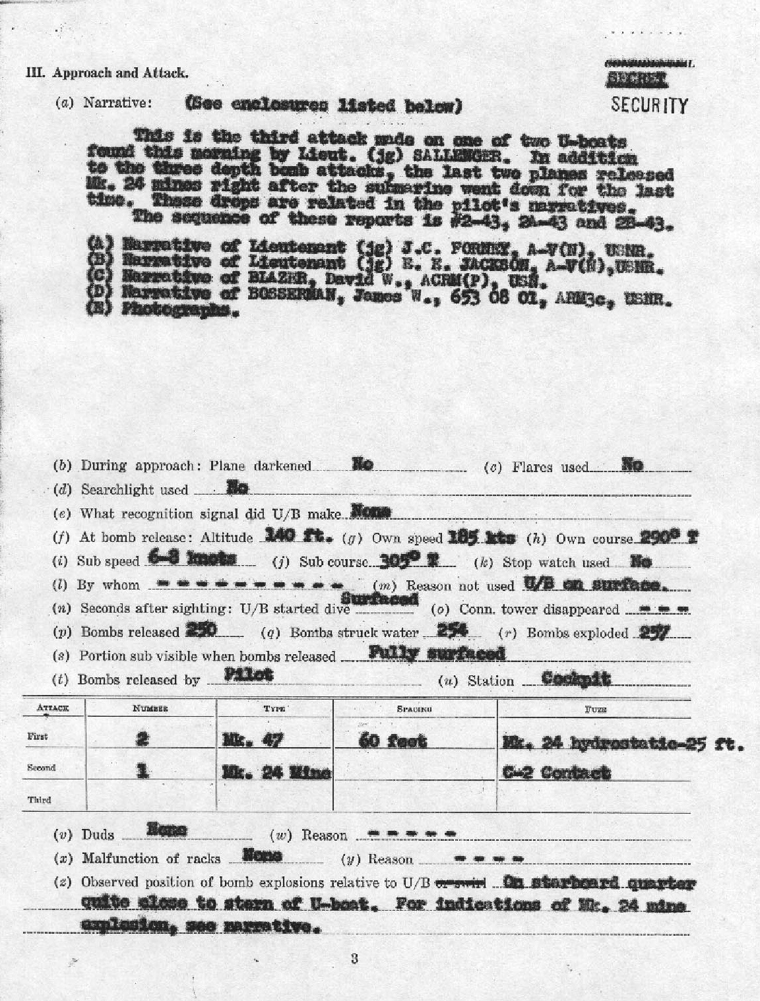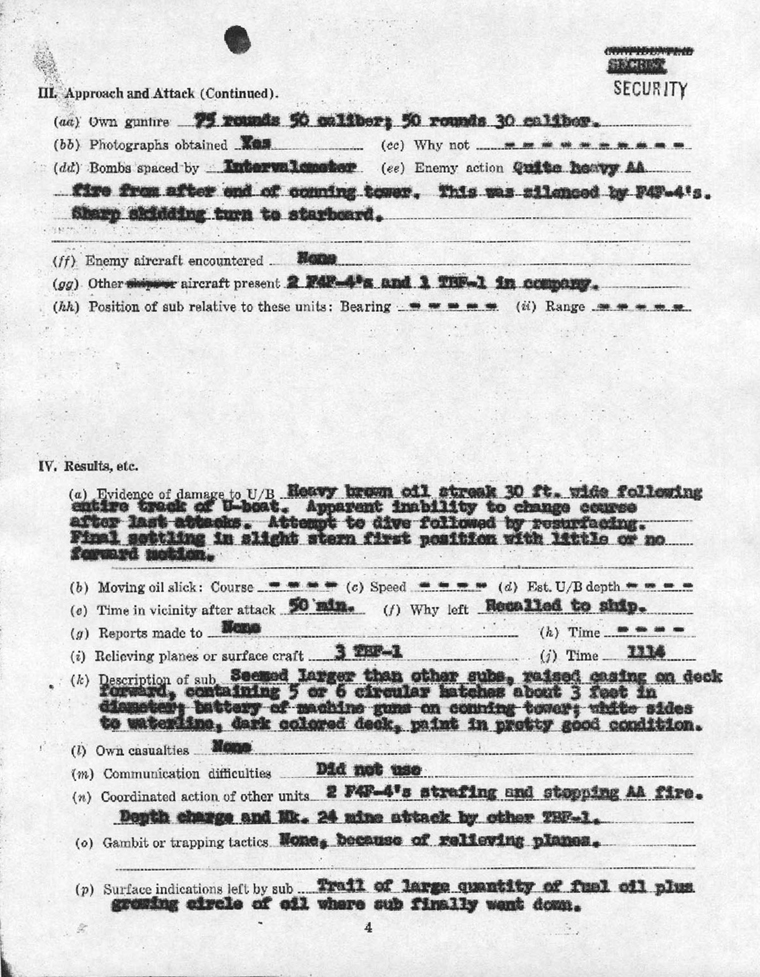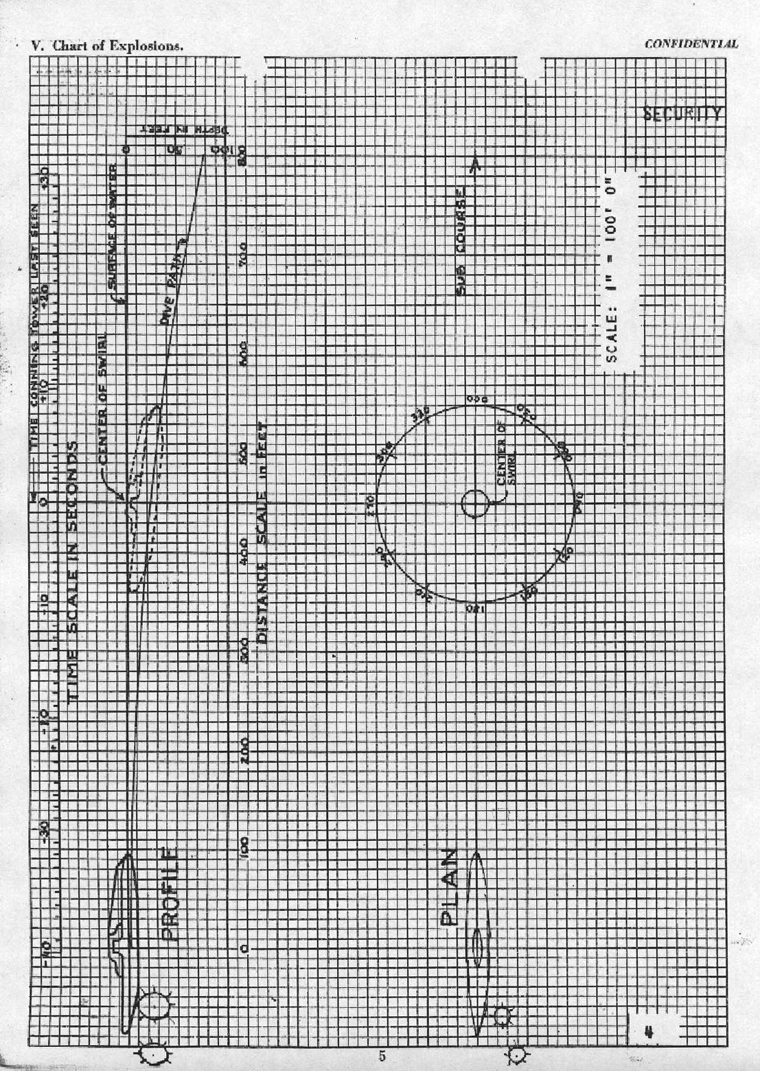



COMPOSITE SQUADRON ONE |
|||
| SECRET-SECURITY | August 7, 1943. |
||
NARRATIVE OF LIEUTENANT (JG) J. C. FORNEY, A-V(N), USNR |
|||
| I first sighted the track of the U-boat, reported by Lieutenant (jg) SALLENGER, about 150 off the starboard bow, distance between 10 to 15 miles. | |||
| I was flying at 5000 feet slightly to the starboard side of Lieutenant STAPLER and Lieutenant HODSON. Lieutenant (jg) JACKSON was flying in a fighter on my wing. We all pushed over slightly, to gain speed, and leveled off at about 3000 feet. The sub was making a right turn, so I slid over to the port side of Lieutenant STAPLER and followed him in on the attack. | |||
| Lieutenant HODSON made two strafing runs before Lieutenant STAPLER dropped his depth charges. Lieutenant HODSON's first run was off the starboard quarter and his second off the port quarter. Lieutenant STAPLER then made his run from the starboard side about 200 off the stern. I observed both his charges go just over with the first almost next to the port side abreast of the conning tower. The explosion covered the sub from view. | |||
| I then signaled for Lieutenant (jg) JACKSON to start his strafing attack. I made my run about 150 off the stern. After dropping, I pulled out to the left and observed both my charges go off slightly aft and on the starboard quarter 20-25 feet. The explosion was close and also covered the sub from view. | |||
| I circled at 1500 feet while the fighters strafed the sub. The sub then went into a right turn, apparently trying to dive, but it had more the appearance of "Mushing" down stern first. Then it did go under the water. I dropped my flaps and wheels to make an approach to release the Mark 24 mine. While I was still aft of the sub and losing speed, the sub came up again, not fully surfaced, but with the deck forward of the conning tower awash. Seeing this, I pulled up my flaps and wheels and made a left turn, not dropping the mine. | |||
| After this, the stern seemed to settle slowly and the sub had practically no forward motion. The last I saw of it was the bow going under with conning tower already down. | |||
| ENCLOSURE (A) - 1 - | |||
COMPOSITE SQUADRON ONE |
|||
| SECRET-SECURITY | August 7, 1943. |
||
NARRATIVE OF LIEUTENANT (JG) J. C. FORNEY, A-V(N), USNR CONT'D |
|||
| I then circled and half a minute after disappearance, at an altitude of 200 feet, speed 120 knots, I dropped my mine about 400 feet ahead and to port of the spot the sub was last seen. There was no noticeable swirl. | |||
| Lieutenant STAPLER had dropped his mine on the starboard side about 10 seconds before. | |||
| I then circled the spot at about 95 knots and after about 4-1/2 or 5 minutes, my radioman told me he saw a shock-wave on the water forward and to starboard of where the sub was last seen. A few minutes later I noticed what appeared to be traces of air rising to the surface forward of the spot that my radioman told me he had seen the shock wave. The disturbance had the appearance of large rings with the water being a very light color. This continued for about 5 to 8 minutes. | |||
| Nothing more was seen. The only personnel I observed on deck was during my depth charge attack, at which time I noticed three or four men running from stern to the conning tower. | |||
| J. C. FORNEY. | |||
| ENCLOSURE (A) - 2 - | |||
COMPOSITE SQUADRON ONE |
||
| SECRET-SECURITY | ||
August 7, 1943. |
||
NARRATIVE OF LIEUTENANT (JG E. E. JACKSON, A-V(N), USNR |
||
| When we arrived, the U-boat was erratically twisting at 6 knots trailing a wide, long oil slick. The other F4F-4 had completed a strafing run and Lieutenant STAPLER in the other TBF-1 made his bombing run. The explosion was very close aboard the port side of the U-boat, completely hiding it. I then went in for my first strafing run before Lieutenant (jg) FORNEY's attack with depth bombs. Though the U-boat remained on the surface after these two attacks, making turns, it looked very sluggish. Lieutenant HODSON and I continued our strafing attacks, giving the U-boat a thorough going over. After one run there appeared to be some smoke coming from just aft of the conning tower. | ||
| After about ten minutes, the submarine seemed to lose almost all forward motion and go under. Less than a minute later the bow and part of the conning tower broached water and then a short time later it disappeared again seeming to settle stern first. I noticed some large air bubbles, 10-15 feet in diameter on the port side of the slight swirl left by the sub. | ||
| The TBF airplanes then dropped their mines. The first was dropped around 25 seconds after disappearance, ahead and starboard, the second 10 seconds later, ahead and port. After circling about 5 minutes looking for indications of destruction other than the large spreading patch of oil, I observed an instantaneous dark blue circular disturbance in the water a little ways ahead of where the U-boat was last seen. This was about 75 feet in diameter and was similar in appearance, but smaller than the effect of a depth bomb just before the water shoots up. | ||
| At first there was quite a bit of AA fire from the batteries of 20mm on the conning tower. However, after 3 or 4 strafing runs, it was pretty well silenced. The gunners seemed to be well protected and I actually saw only two men, both in the conning tower but neither manning the gun. Both of these men appeared to be hit. | ||
| E. E. JACKSON. | ||
| ENCLOSURE (B) | ||
COMPOSITE SQUADRON ONE |
||
| SECRET-SECURITY | ||
August 7, 1943. |
||
NARRATIVE OF BLAZER, David William, 261 61 39, ACRM(P), USN |
||
| I was in the center bay as lookout with binoculars when pilot told me to go aft and get ready for an attack. I checked switches for armament and broke out the camera. As we went down, I lay in the tail to try for some pictures of the bomb drop and explosion. The depth charges hit a little short on starboard side. During pull out, I lost the explosion from sight momentarily. As we banked, a turret went into action and strafed him. We had to stay out a considerable ways to remain clear of fighters, who were strafing vigorously. | ||
| All this time anti-aircraft fire was coming from the sub just at the rear of conning tower. No personnel were in sight as far as I could see, but guns were still firing from sub. Afterwards, sub made right turn and kept right turn until submerged. Pilot immediately went into position for an attack with mine, but in about 28 or 30 seconds, sub surfaced again showing only the bow and conning tower, so the planes pulled up without dropping. | ||
| For a few minutes the sub continued very slow right turn, then conning tower began to go under again. These last few minutes sub had nose high and stern under and showed a pronounced slowing of speed when conning tower disappeared. Fighter pilot called over radio that sub had submerged, and we went in to drop mine. | ||
| There was a round circle of pale blue water but no pronounced swirl. The mine was dropped ahead to port of this on the opposite side from the other plane. Four and one-half minutes later, I clearly saw a large shock wave ahead and to starboard, calling pilot's attention to it. A minute or so later, I saw a circle of light blue water with air bubbles rolling up. | ||
| We circled for some time, but nothing else showed. | ||
| David William BLAZER. | ||
| ENCLOSURE (C) | ||
COMPOSITE SQUADRON ONE |
||
| SECRET-SECURITY | ||
August 7, 1943. |
||
NARRATIVE OF BOSSERMAN, James W., 653 08 01, ARM3c, USNR |
||
| After I heard my pilot say, "Get ready, there it is," I got the turret in operation. I first sighted the sub over our port wing as we were diving on it. We dropped our charges and banked to the left as I opened fire. As we pulled away, the snake-like tracks the sub left were easy to see. We had followed the other TBF on the dive, and we now circled the sub as the fighters continued to strafe it. The charges seemed to further disable the sub, as it stopped maneuvering and went into a circle to the right. The fighters continues to strafe as we watched. Finally it appeared to sink or submerge only to reappear about 30 seconds later. After more strafing, it went down, stern first, rather lazy-like., and we again followed the other TBF in and dropped our mine. Markers were dropped, and a few minutes after our mine was dropped I saw the after part of a water tremor indicating an explosion. As we continued to circle, a patch of water bubbles began to appear near where I had seen this tremor. When we finally left the scene, the pattern or snake-like tracks left in the sub's wake, were still plainly visible. A large, but not uniform, patch of brown oil slick appeared near the spot also. | ||
| At the beginning of the attack, I am quite sure that men were hurrying around on the deck. There was also a considerable amount of anti-aircraft fire, which was not too accurate. Due to the fact that the fighters were strafing to such an extent, it was not possible for the gunner in the turret to do much firing. | ||
| James W. BOSSERMAN. | ||
| ENCLOSURE (D) | ||